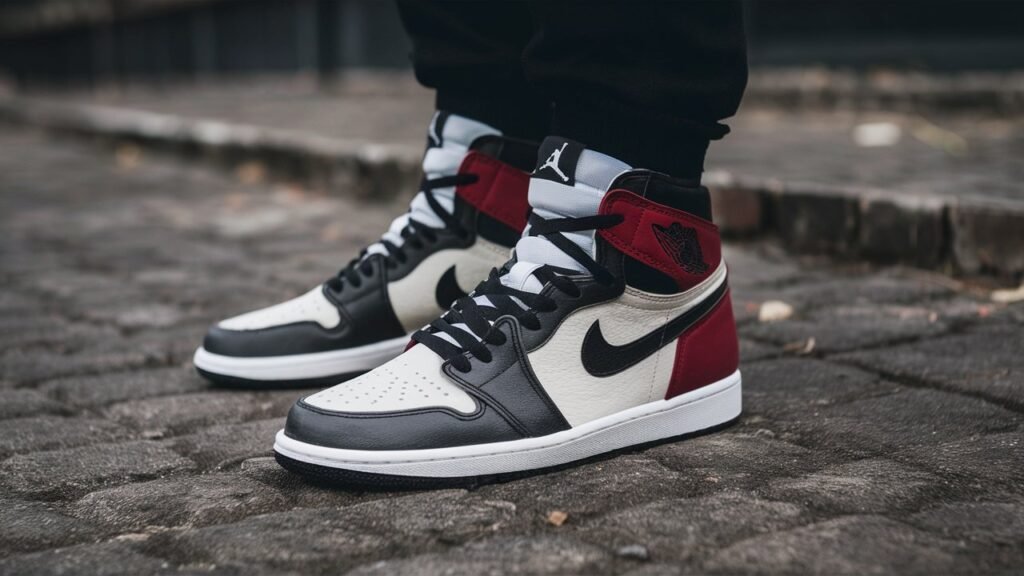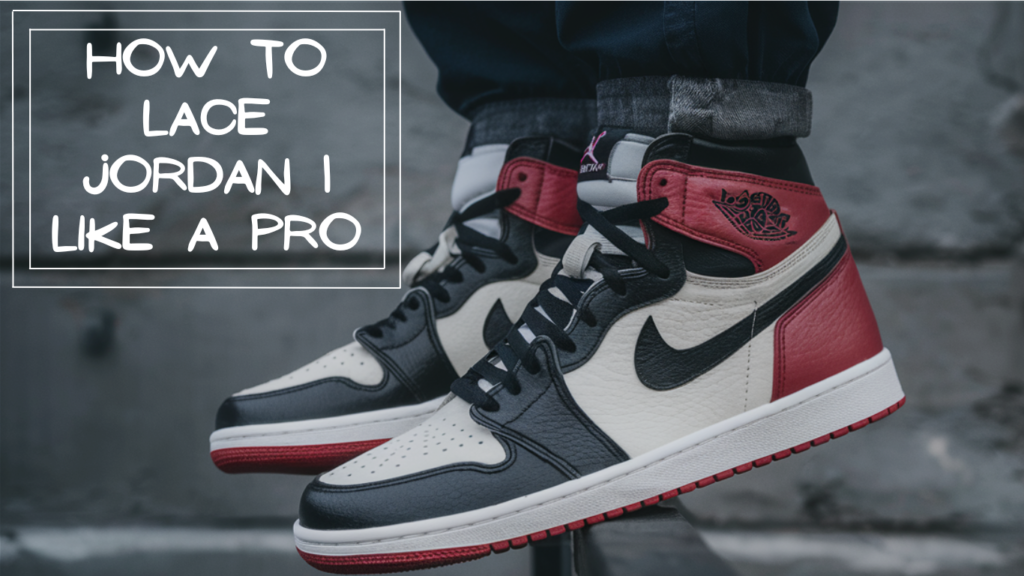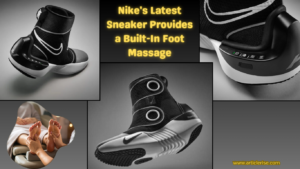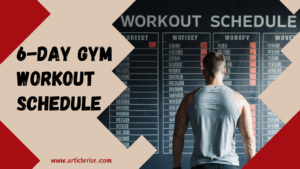How to lace Jordan 1 sneakers correctly it is crucial to understand the history and design details of the Jordan 1. This knowledge will not only enhance the appearance of the sneakers but also ensure maximum comfort.
Importance of Proper Lacing
Lacing your Jordan 1s can prevent discomfort, enhance the longevity of your sneaker, and significantly enhance your overall style. The proper lacing technique aligns with your fashion sense and practical needs.
Overview of Jordan 1 History and Design
The Jordan 1, a game-changer in 1985, is a sneaker with a story. its high-top design and vibrant colorways set it apart, making it a top pick for athletes and collectors. The shoe’s structure, multiple eyelets, and robust build offer a canvas for endless lacing possibilities.
Choosing the Right Laces
Material Considerations
Laces come in various materials like cotton, polyester, and leather. Cotton laces are soft and flexible, while polyester offers durability and resistance to fraying. Leather laces add a premium touch but require more care.
Length and Width
Jordan 1s typically require laces between 54 and 63 inches, depending on your lacing style. Thinner laces provide a sleek look, while wider laces can make a bold statement.
Color Selection
The lace color is a crucial aspect of customization. Match your laces with your outfit for a coordinated look, or choose contrasting colors to make your sneakers stand out.

Preparing Your Jordan 1
Cleaning Your Sneakers
Before re-lacing, clean your Jordan 1s thoroughly. Remove any dirt or debris from the eyelets to ensure smooth lacing.
Checking Lace Holes and Eyelets
Inspect the eyelets for damage. If you find loose or frayed holes, reinforce them with metal eyelets or stitching. When using metal eyelets, be careful to avoid injury. If you choose stitching, use a needle with a blunt tip to prevent accidental punctures.
Classic Criss-cross Lacing
Step-by-Step Instructions
When lacing up your Jordan 1s, it’s best to start by threading the lace through the bottom eyelets and ensuring both ends are even. Then, cross the laces over each other and thread them through the next set of eyelets. Keep repeating this sequence until you reach the top.
Benefits of Criss-cross Lacing
This traditional method provides a secure fit and evenly distributes pressure across the foot, making it ideal for everyday wear.
Bar Lacing Technique
How to Achieve the Bar Lacing Look
Insert the lace into the bottom eyelets, pulling both ends upwards. Instead of crossing, thread each lace straight across the shoe. Skip one eyelet and repeat until the top.
Pros and Cons of Bar Lacing
Bar lacing offers a clean, streamlined appearance, perfect for casual and formal settings. However, it may not provide as tight a fit as other methods.
Diamond Lacing Pattern
Detailed Guide to Diamond Lacing
Start by criss-crossing the laces at the bottom of the shoe. Then, create a diamond shape as you lace upwards, threading the laces through the eyelets in an alternating pattern. This will help ensure that the lacing is secure and looks good.
Aesthetic Appeal of Diamond Lacing
The intricate and eye-catching pattern on these sneakers adds a unique and stylish flair, making them a standout conversation piece wherever you go.

Ladder Lacing Method
Steps to Create Ladder Lacing
Ladder Lacing is a method that ensures a very snug fit and provides stability and support for athletic activities. To achieve this, thread the laces vertically through the first eyelets. Then, weave each lace horizontally across the shoe, creating a ladder-like structure.
Practical Advantages
Ladder lacing ensures a very snug fit, which provides stability and support for athletic activities.
Spider Web Lacing
Intricacies of Spider Web Lacing
Spider Web Lacing is a unique technique that starts with a standard criss-cross. Then, it creates a web effect by threading the laces through multiple eyelets in a zigzag pattern. This intricate pattern adds a unique flair to your sneakers, making them a conversation piece.
Visual Impact of Spider Web Lacing
The spider web design is visually striking and adds a touch of complexity to your Jordan 1s.
Customizing Lace Tips (Aglets)
Personalizing Your Aglets
Aglets can be customized with different colors or materials to match or contrast with your laces. Metal aglets add a premium feel.
DIY Aglet Replacement
To give your worn-out aglets a refreshed look, you can use pliers to remove the old ones and then attach new ones using adhesive. This simple process can help restore the appearance of your shoelaces and give them a new lease on life.
Tightness and Comfort
Adjusting Lace Tension
To achieve a personalized fit, adjust the tension at different shoe parts. Tighten the laces around the ankle for support and keep them slightly looser around the toes for comfort.
Ensuring a Snug Fit
Ensure that your foot is positioned securely and comfortably within the shoe. The appropriate lacing technique can help prevent blisters and enhance overall shoe comfort.
Maintaining Lace Integrity
Tips for Prolonging Lace Life
Remember not to tighten your shoelaces too much, as that can strain the material unnecessarily. Also, keep your laces clean to avoid dirt and grime building up, which can make them deteriorate faster. Check for signs of wear, like fraying or thinning, and switch out your laces when you notice these indicators.
Preventing Lace Wear and Tear
When selecting laces for your shoes, opt for high-quality, durable options to ensure longevity. Avoid dragging your laces on rough surfaces, leading to fraying and damage. Additionally, consider double-knotting your laces to provide extra security and prevent fraying.

Troubleshooting Common Issues
Addressing Uneven Lacing
If your shoelaces are uneven, carefully untie them and re-thread them, mirroring each step on one side with the other. This will help ensure that your laces are even and properly aligned.
Fixing Loose Eyelets
If you notice that the eyelets on your shoes have become loose, you can quickly tighten them using a small repair kit. These repair kits are commonly available at most shoe stores.
Enhancing Performance
Impact of Lacing on Athletic Performance
Different lacing techniques can enhance performance by providing better foot support. For example, Ladder Lacing is ideal for sports requiring lateral movements, as it allows for a very snug fit that prevents the foot from sliding inside the shoe, thus improving stability and agility.
Optimizing for Different Activities
Choose lacing methods based on your activities, whether for casual wear, running, or playing basketball.
Lacing for Different Occasions
Casual Wear vs. Sporty Look
Criss-cross lacing works well for casual looks, while bar lacing suits a more polished appearance.
Formal and Semi-Formal Styles
Consider choosing bar lacing for a more formal and elegant look that complements your outfit. Alternatively, diamond lacing can also be an excellent option for formal settings, adding a touch of culture to your overall appearance.
Expert Tips and Tricks
Insights from Sneaker Enthusiasts
Sneaker enthusiasts often suggest trying out different lacing techniques to determine the most comfortable and stylish option that suits your foot shape and personal preferences. Different lacing styles can provide varying levels of support and enhance the sneakers’ overall look.
Innovative Lacing Hacks
One can achieve a distinct appearance by utilizing two different colored laces or by incorporating charms and beads onto their laces. This will imbue a personalized touch to one’s attire and ensure one’s shoes garner attention.
Conclusion
Recap of Key Techniques
Understanding various lacing methods can transform the fit and appearance of your Jordan 1s. Each technique offers unique benefits and style elements.
Encouragement to Experiment with Styles
Now that you know all these cool ways to lace up your shoes, it’s time to get creative. Mix and match, or even come up with your lacing style. Try different colors and materials to give your shoes a unique look that shows your personality and style.







